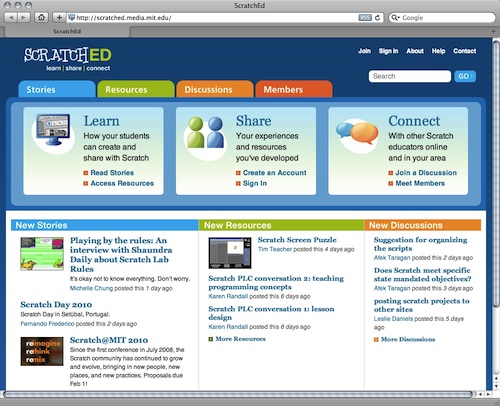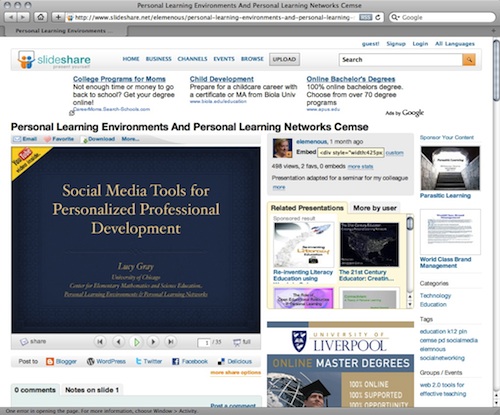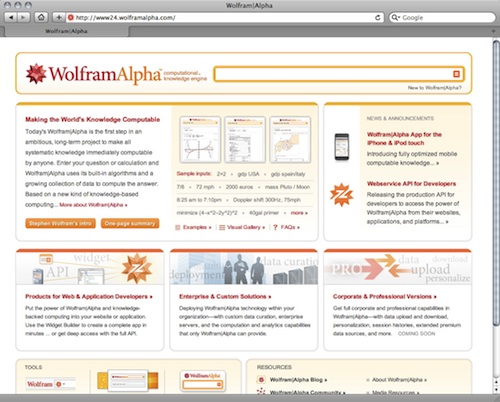Web 2.0 in Instruction: Adding Spice to Math Education
- By Patricia Deubel
- 02/17/10
"Web 2.0 has the potential to change the way we learn and teach mathematics not unlike what Apple Computer did back in 1984 with their launch of the Macintosh, which changed the way everyone uses computers today," according to Ihor Charischakof CLIME Connections, the Council for Technology in Math Education (2009). However, math education has not kept up with Web 2.0.
Maria Droujkova (2009), developer of Natural Math, stated, "The main trend is the lag of mathematics behind other subjects in class-centered Web 2.0 communities for children, and an even larger lag in informal, recreational communities. Children's mathematics remains very much confined to classes, homework, and standardized tests, or activities that closely imitate them. Most class-centered mathematical communities are not sustainable, in that they dissolve after the class ends, even if the artifacts stay available online. Many existing sustainable math-oriented communities are intellectually elitist and demographically exclusive" (pp. 1-2).
These are alarming, but true, observations on the state of math education. What might be done?
As a leader in grassroots efforts to change that, Droujkova (2009) formulated a framework supporting Natural Math and Math 2.0 projects, which views math education in a cultural context essential for the 21st century Age of Globalization. Learning is defined as taking on roles in communities and networks and includes "many events at individual, family, local community and group, and global network levels. A framework encompassing these events can help bring about mathematics education changes, and, in particular, to orient individual Web 2.0 educational projects to wider vision and goals" (p. 2). Her framework includes five directions: mathematical authoring, community mathematics, humanistic mathematics, executable mathematics, and the psychology of mathematics learning and education.
I began a quest to discover why this framework is relevant, starting with some interpretations of Math 2.0 and then investigating examples on the Internet that support it. These are some of the resources I've found that might help propel math instruction into the era of Web 2.0.
Math 2.0
Math 2.0 has been interpreted with a variety of phrases. Participants in weekly Math 2.0 Interest Group meetings co-created a definition where Math 2.0 links math education to social networking; involves using Web 2.0 tools to build and share knowledge of math concepts; is collaborating and connecting with others on problem solving, math thinking, and learning; and is an ability of users to create their own math-rich social objects using Web technologies.
Charischak(2009) posted the full chat log of one of the first meetings to view other perspectives. Perhaps one of the best examples of what social math is all about is the constantly growing collaborative slide show, Where is Social Math? (You are free to embed this on your own wiki or blog.)
Mathematical Authoring
"Tools and practices of user-generated content, as well as the internet participatory trends of co-production, crowdsourcing, and open educational resources can powerfully support mathematical authoring" (Droujkova, 2009, p. 3). For example, Scratch, created at MIT Media Lab, is primarily for ages 8 and up. This free, downloadable, programming tool makes it easy to create interactive stories, animations, games, music, and art--and share those creations on the Web. Students learn math and computation ideas, the process of design, how to work collaboratively, how to think creatively, and how to reason systematically. Educators can join ScratchEd, an online community to learn more, share stories, exchange resources, ask questions, and find other Scratch educators.
 |
Wikiversity invites teachers, students, and researchers to join their endeavors to create open education resources and collaborative learning communities. The project is devoted to learning resources, learning projects, and research for use at all levels and types of education from pre-school to university, professional development, and informal learning. Explore the Math Portal. Likewise, PlanetMath's content is created collaboratively by members of its virtual community, which promotes itself as "Math for the people, by the people." Among features are a math encyclopedia, books, papers, and discussion forums. High school mathematics is one of the top starting points for investigating the site. Content is written using LaTeX, the typesetting language for technical and scientific documents. While this might be a drawback for some, there is online support for learning to use it.
Community Mathematics
"For community mathematics, free, well-designed communication platforms such as nings, blogs, wikis, microblogging, forums, aggregators, and distributed content mash-ups can support online and local math clubs and math circles, topical discussion and study communities, and networks growing around a variety of particular math endeavors: competitions, educational philosophies, comic strips, books, or curricula" (Droujkova, 2009, p. 3). Math247 is a particularly valuable wiki for math educators to connect with others and parents hoping to help their children with math. It contains a library of mathcasts and pencasts by students and teachers and help for creating those.
The Art of Problem Solving (AoPS) is exemplary for its extensive resources and opportunities for strong math students in middle and high school to participate in its community, which has more than 70,000 members worldwide, and to prepare for prominent math contests. There are forums on numerous topics, member blogs, math jams (free online classes), and a wiki. The AoPSWiki supports educational content useful to students of math, science, computer science, technology, and other problem-solving topics. Students can play AoPS For The Win!, an online multiplayer math game modeled after MathCounts National Countdown rounds. They can further hone their math skills using the adaptive learning system called Alcumus, which contains more than 11,000 math problems with solutions and more than 60 video lessons.
The National Association of Math Circles promotes social contexts in which students enjoy learning mathematics. The aim of a math circle is to bring mathematical professionals in direct content with pre-college students in informal settings to work on interesting problems and math topics. The movement is growing in North America with an extensive list of math circles and clubs in several states, including math circles for teachers.
Educators might wish to develop their own personal learning networks and then help their students to develop or refine theirs. The Innovative Educator (2008) provides five steps for doing that, advising educators to join an existing professional social network, start reading five blogs of interest, set up an iGoogle account with your professional e-mail address, and use an aggregator like Google Reader to subscribe to the blogs you read, start to participate in those blogs, and start reading Twitter.
Lucy Gray of the University of Chicago's Center for Elementary Mathematics and Science Education further describes the how-tos and provides numerous resources to consider in Social Media Tools for Personalized Professional Development. Your professional social network might include the Middle School Math and Science Ning. You can find math blogs of interest via Google Blog Search. Tweak your thoughts by looking at the Mathematics Education Research Blog, the Teaching Math Blog from open-education resource HippoCampus, or MisterTeacher's blog by grade 5 teacher Jamie Tubbs. A search on Twitter will reveal a math community from which you can select people of interest to follow; Gray's slideshow includes a list of possibilities.
 |
Humanistic Mathematics
Humanistic mathematics "promotes activities that an audience can enjoy. On the Web, this includes infusing mathematics into robust artistic and musical communities; creation and viral spread of appealing math-rich media; and developing newbie-friendly tools and communities supporting authoring of such media" (Droujkova, 2009, p. 3).
Pixton is a social cartoon making Web site that anyone can join. The site includes safety tips, tips for parents, and a special section for school use. A site search reveals many math cartoons. You can leave comments, rate your favorites, exchange messages with friends, build a fanclub, print and download your own comics, e-mail them to others, and post them on other Web sites and blogs. The point of cartooning in math class is that it encourages writing and enables students to organize and consolidate their mathematical thinking though communication, which the National Council of Teachers of Mathematics (2000) supports in its Principles and Standards for School Mathematics. Students might create a comic to explain a math concept or a new vocabulary word or show how they solved a problem. They might share their feelings or a concern about their learning.
A math class would certainly be spiced up with math raps, one way or the other. The Rappin' Mathematician explains How to Write Your Own Math Rap. Need examples? His Mathraps.com contains a few free raps. You can also get inspired by the short video of math teacher Matt Hildahl on Using Math & Rap. It includes the rap his students created on the Pythagorean theorem. The Google collection of math raps illustrates how teachers and students have shared their creations with a world-wide audience.
Math has a beauty that is sometimes not conveyed to our students. Mathematics Imagery from the American Mathematical Society will enable students to explore the relationship between mathematics and art. The collection of albums is extensive--from snowflakes, fractals, quilts, and woven beads to origami, computer-generated landscapes, tesselations, and geometric sculptures. Create some beautiful fractals and share those using resources at Amazing Seattle Fractals.
Ethnomathematics, the study of the relationship between mathematics and culture, also falls within this humanistic category. It might seem a challenge to incorporate this area into math classes because of mandated curriculum and the standardized test movement, but it links math to the real world. Culturally Situated Design Tools for teaching math and computing through culture comes with lessons and software for students to create their own cultural designs associated with African, African-American, Latino, and Native American cultures, as well as youth subcultures. Explore other ways to incorporate this area into your classroom using resources from the International Study Group on Ethnomathematics. Radical Math might also appeal to educators interested in integrating issues of social and economic justice into their classes, as this is one area of particular interest that affects youth staying in school and connecting to the world around them. There are links to more than 700 lesson plans, articles, graphs, charts, data sets, maps, books, and Web sites to bring these issues into the classroom. The how-to guidelines promote culminating projects and sharing those with the community.
 |
Executable Mathematics
"Web 2.0 brings several crucial changes to this field of executable mathematics, including zero-cost distribution of virtual manipulatives; an invitation for everybody to create their own math-rich objects through programming or "construction set" mash-up environments; situating math objects in multi-user virtual worlds; and ease of sharing and continuing development in open educational resource communities" (Droujkova, 2009, p. 3). Perhaps two of the most well known sources of virtual manipulatives available at no-cost are from Shodor Foundation's Interactivate and Utah State University's National Library of Virtual Manipulatives. Computing Technology for Math Excellence has an entire section devoted to math manipulatives and interactives on the Web.
International award-winning GeoGebra is free, open-source, dynamic mathematics software for learners middle school and up that joins geometry, algebra, and calculus. According to Markus Hohenwarter, principle developer, and Judith Preiner (2007), you can use it as a "teaching tool and to create interactive Web pages for students." It "helps foster experimental, problem-oriented and discovery learning of mathematics" (Abstract section). They illustrate the basic ideas of the software and some of its versatile possibilities by discussing several interactive examples. You can do constructions with points, vectors, segments, lines, conic sections, and functions and change them dynamically afterward. You can enter equations and coordinates directly. The software can deal with derivatives and integrals of functions and offers commands like Root or Extremum. Educators can join the GeoGebraWiki to post their creations and view the work of others. For example, see the main page in English for free teaching materials created with GeoGebra.
Executable mathematics also includes applications like Wolfram|Alpha. Enter a question requiring a factual answer or calculation, including one in which graphing is involved, and Wolfram|Alpha will compute the answer. Anyone can use this resource. It's not just for math, as you can ask questions on engineering, physics, places and geography, dates and times, money and finance, units and measures, chemistry, health and medicine, foods and nutrition, colors, music, and much more. This is an emerging technology that will continue to grow.
 |
Psychology of Mathematics Learning and Education
"Psychology of mathematics education incorporates theories of teaching and learning, studies and practices of meta-cognition, developmental awareness, and support of emotional well-being such as math anxiety reduction. Web 2.0 requires a shift toward more social views on the psychology of mathematics education and its role, within this framework, of supporting the other four dimensions" (Droujkova, 2009, p. 3). Connectivism, which is George Siemens' theory for learning in the digital age, is particularly well suited to the Natural Math framework. In a 2006 THE Journal publication, I discussed The Value of Connectivism. Its essence is that learning is viewed as a connections/network-forming process. While not everyone agrees with this theory (e.g., see A Stand Against Connectivism), there are several groups examining its merit within the Ning called Connectivism Technology Web 2.0 Education Learning and Research.
The Networked Student, posted on YouTube in 2008, is an actual project completed by high school students to illustrate how this theory might be put into practice. Echoing Cheryl Lemke and Ed Coughlin (2009), I conclude it exemplifies how technology can empower students by enabling democratization of knowledge, participatory learning, authentic learning, and multimodal learning. However, it does remind educators that multimodal learning, combining sophisticated media with text and visuals, might also challenge educators in terms of helping learners to interpret and understand multimedia messages.
Students' need for speed, multitasking, learning on demand, and staying connected with each other changes the psychology of learning, adding an additional level of awareness needed for how to approach teaching to deal with potential health problems and math anxieties that might arise. According to Marilee Sprenger (2009), rather than being productive, excessive connectedness can lead to stress, which, over time, can potentially "lower the effectiveness of the immune system, weaken cognitive functioning, and, in some cases, lead to depression" (p. 36)--and potentially weaken the development of emotional intelligence in dealing with face-to-face situations (e.g., reading facial cues and body language). In Urs Gasser and John Palfrey's (2009) view, multitasking is not going to go away. Their review of literature on this topic revealed a "loss of attention and the time spent switching from task to task is likely to have an adverse effect on digital natives' ability to learn complex new facts and concepts" (p. 18).
Thus, in support of a psychology of math education, MathVIDS provides a series of videos illustrating how teachers might implement metacognitive (learning) strategies. Each is accompanied by a slide show with text and audio explanations of the video. MathVIDS also has a learning community wiki. Most likely, everyone has experienced math anxiety at one time or another. It is a learned emotional response that often comes from negative experiences working with teachers, tutors, classmates, or family members. But math anxiety can be controlled using resources such as those provided at WEGO Health, a Boston-based endeavor.
Bottom Line
American education in the Age of Globalization should "inform the public about the possibilities brought about by globalization, encourage education innovations, inspire educators with genuine support, diversify and decentralize curriculum, and educate children as confident, unique, and well-rounded human beings” (Zhao, 2009, p. 198). In keeping with Zhao's recommendations, Droujkova's (2009) Natural Math framework is worthy of consideration as we also plan to adopt and implement a set of common core standards in the United States. The resources presented in this quest just whet the appetite for what can be done to advance math education. A mind map of the extent of this framework is available at mind42.com. Join the Math 2.0 Interest Group, an international network of researchers, educators, families, community leaders, and technology enablers. There are weekly events, where hosts typically talk about their research and development projects and invite people to collaborate.
References Charischak, I. (2009, July 21). In search of Math 2.0 [blog post]. Retrieved from http://climeconnections.blogspot.com Deubel, P. (2006, September 6). The value of connectivism. T.H.E. Journal. Retrieved from http://thejournal.com Droujkova, M. (2009, July 14). Where is math 2.0? Alarming trends and hopeful frameworks circa 2010 [blog post]. Retrieved from http://www.naturalmath.com Gasser, U., & Palfrey, J. (2009). Mastering multitasking. Educational Leadership, 66(6), 15-19. Hohenwarter, M., & Preiner, J. (2007, March). Dynamic mathematics with GeoGebra [online]. Journal of Online Mathematics and Its Applications, 7, article 1448. Retrieved from http://www.maa.org Lemke, C., & Coughlin, E. (2009). The change agents. Educational Leadership, 67(1), 54-59. National Council of Teachers of Mathematics (2000). Principles and standards for school mathematics. Reston, VA: Author. Retrieved from http://standards.nctm.org/ The Innovative Educator. (2008, October 12). 5 things you can do to begin developing your personal learning network [blog post]. Retrieved from http://theinnovativeeducator.blogspot.com Sprenger, M. (2009). Focusing the digital brain. Educational Leadership, 67(1), 34-39. Zhao, Y. (2009). Catching up or leading the way: American education in the age of globalization. Alexandria, VA: ASCD. |
About the Author
Patricia Deubel has a Ph.D. in computing technology in education from Nova Southeastern University and is currently an education consultant and the developer of Computing Technology for Math Excellence at http://www.ct4me.net. She has been involved with online learning and teaching since 1997.